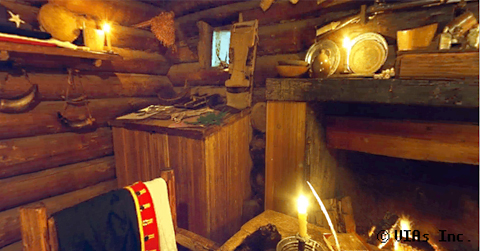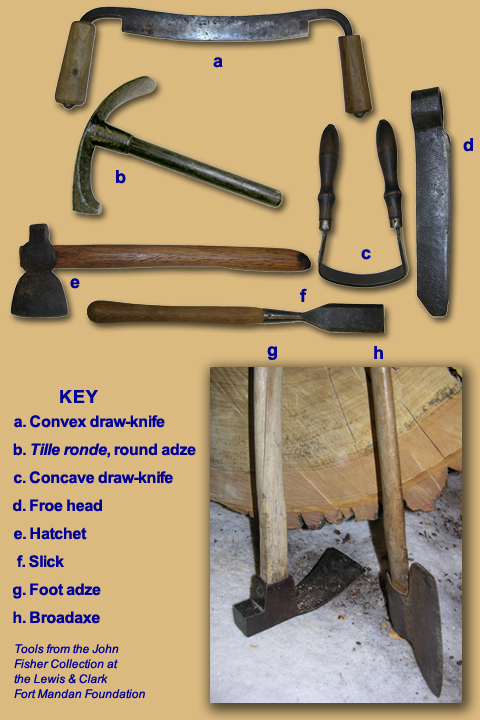The Expedition’s Tool Chest
Figure 36
Canoe-carving Tools
Tools from the John W. Fisher Collection at the Lewis & Clark Fort Mandan Foundation.
a. Convex draw-knife: Shaping blades of paddles
b. Tille ronde, round adze: Finishing inside of canoe hull
c. Concave draw-knife: Shaping throat, shaft and grip of canoe paddles
d. Froe head: Splitting planks for thwarts
e. Hatchet: Single-beveled hatchet for intermediate finishing of hulls
f. Slick: Removing bark from logs
g. Foot adze: Initial hollowing-out of hulls
h. Broadaxe: Single-beveled broadaxe for smoothing of outer hulls
Lewis made lists of requirements, and he also kept records of purchases. Exactly what tools arrived at the Knife River Villages may not ever be known, but the assortment certainly would have been impressive. Lewis’s “List of Requirements”[1]Jackson, I:69-75. is an important historical document even though it is of uncertain date and purpose, but most of the items the expedition actually carried can be found in the “Orders from the War Department”,[2]Jackson, I:75-93. or, perhaps more inclusively, in the “Summary of Purchases”.[3]Jackson, I:93-99. But by the time they reached Saint Louis, Lewis had tripled the number of men on the expedition. The captains’ needs in terms of both personnel and materiel increased so much that they had to buy more of many items, and some others they hadn’t thought of before.
For example, the Purveyor of Public Supplies bought two “shingling hatchets” for the expedition, but no froes with which to rive the shingles, not to mention planks. However, according to a list made by Clark on 7 December 1805, the day they began construction of Fort Clatsop, one “Frow” and one “malet” inexplicably showed up in the company’s toolbox. If they weren’t procured at the last minute in Philadelphia, they might have been bought in St. Louis, if not in some town along the Ohio River. But how many more items did they add, and what were they? We simply don’t know, and possibly never will.
Canoe Making Tools
The list of tools desired includes many useful for making canoes: 4 drawing knives, 2 augers, 24 files, 12 dozen chisels, 2 foot adzes, 2 pick adzes. And a list of tools actually purchased includes: “some” drawing knives, handsaw files, rasps, 3 socket chisels, 3 mortise chisels, 2 handsaws, 4 drawing knives, 17 dozen(!) files and rasps, 2 hatchets, and 18 “small falling axes.” As noted above, there were probably other purchases of which no record has survived. Naturally, some of the items might have been intended for trade with the Indians. Nevertheless, one would think that 17 dozen files and rasps, plus draw knives and planes, would be sufficient to smooth the outsides of 6 canoes.
Although the sketchy journal treatment of the canoes leaves us to draw inferences, I feel confident that given their time, their skill, and these tools, the rough and primitive look of most replica canoes is a mistake: in a few hours the men could and would have shaped and smoothed a hull, as was standard at the time, to lessen its friction and resistance to the water, for the long pull upriver.
What could they do with these tools? As Huser notes, “Patrick Gass was a skilled carpenter responsible for building the expedition’s winter quarters at Fort Mandan and at Fort Clatsop.”[4]Huser, 182. At Camp Dubois, in Illinois across the Mississippi from the mouth of the Missouri, Clark and his recruits raised simple cabins for themselves, and made some improvements to the barge, including storage lockers on the deck at the gunnels. The lockers had hinged lids with cleats nailed to them so that when closed they served as catwalks for poling, and when raised served as breastworks against arrows. That’s approaching cabinet work.
Finding Suitable Trees
Although they had the tools, the trees had limits. At Fort Mandan they were unable to make planks from the cottonwood trees, and had to build with poles. That may be the reason they did not make washstrakes, or boards, to build up the sides of the canoes against the Missouri wind and waves they knew so well. They built multiple buildings at Camp Dubois, Fort Mandan and Fort Clatsop; they carried an arsenal of tools and a forge to make or repair them; when possible, they made their own planks for their housing and sheds; they carried numerous axes, saws, chisels, adzes, hatchets, knives, draw knives, rasps, and files. They could have shaped a log to the canoe they wanted, within the limits of the trees available, and could easily, in a few hours, have shaved a canoe smooth, to Chittenden’s standards: “a round log shorn of all roughness and irregularity . . . strong, light, and easily managed.”
Clark was also looking at boats. In a rare record of appraisal, he watched an Indian canoe at Wood River: Three Potawatomis in a small canoe crossed the Mississippi from the west bank when, as Clark looked on, “the waves was so high & wind blowing with violence that I expected their Canoo would Certounly fill with water or turn over, but to my astonishment found on their landing that they were all Drunk and their Canoo had not received any water.”[5]Moulton, 2:131.
Perhaps Clark was admiring the hull design; perhaps the design of a universe kind to fools.
Lewis’s Desk at Fort Clatsop
Figure 37

Allen McMakin photo, © 1998 by VIAs Inc.
At Fort Clatsop on Christmas Day, 25 December 1805, Joe Field presented each of the captains “a wide Slab hued [hewed] to write on.” It was a surprise then, no doubt, and it still is, for nothing we know about him, either from the expedition’s journals or any biographical information otherwise available, gives us any hint that he was good at fine woodworking—then known as joinery. Maybe, before he enlisted in the Army, he was briefly apprenticed to a cabinet or furniture maker.
Or maybe he had enough latent interest in the craft that he just felt like playing around with it, using one or more of the small tools in the company’s kit—saws and block-planes—and some odds and ends of planks they had rived from western redcedar logs. He may also have had a hand in building a tall sturdy cabinet for each board to rest on (handwriting was a stand-up job for gentlemen and officers in those days). Lewis’s station, recreated by historic anthropologists at the National Park Service’s modern replica of the fort, is pictured above (Fig. 37); Clark’s desk was under a window to the right of the fireplace.
Joe Field was off and running. On the day after Christmas he finished a large table and two benches (foreground in photo) where Lewis could study and write up his natural history specimens, or Clark could spread out his maps.
—Joseph Mussulman

